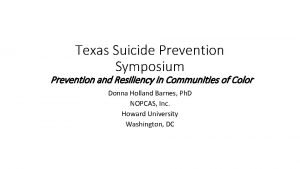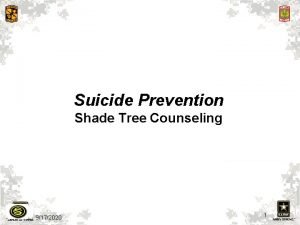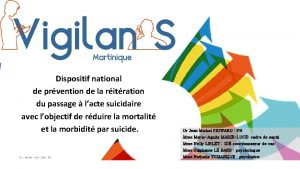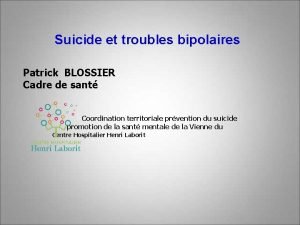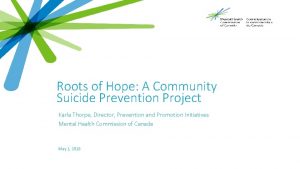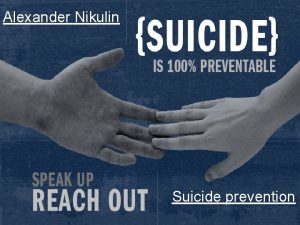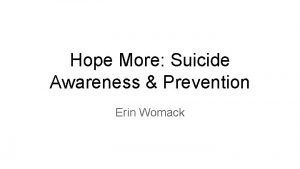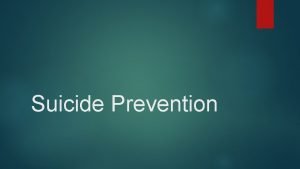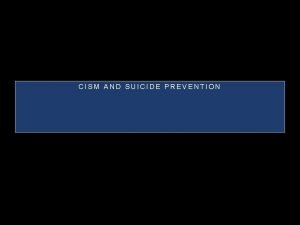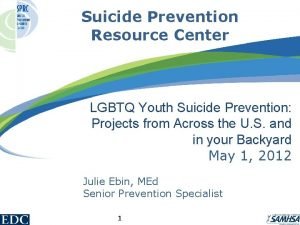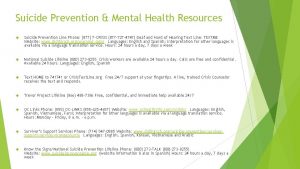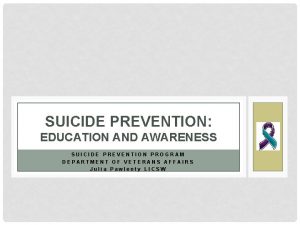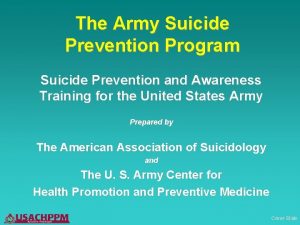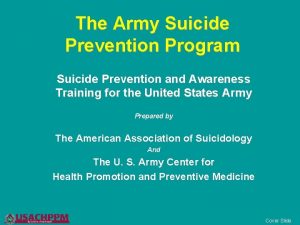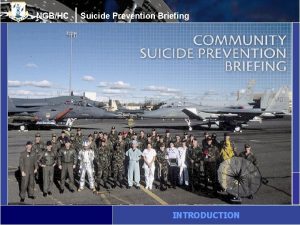Roots of Hope A Community Suicide Prevention Project
















- Slides: 16

Roots of Hope: A Community Suicide Prevention Project Karla Thorpe, Director, Prevention and Promotion Initiatives Mental Health Commission of Canada May 1, 2018

Suicide Prevention – A High Priority

IIMHL: Background • IIMHL match identified key elements of a systemic and evidence-based community suicide prevention approach • Built on best and promising practices and tools

Models Reviewed • World Health Organization Guidelines • Lifespan (Australia) • ‘Help for Life’ Strategy for Prevention Suicide (Quebec) • European Alliance Against Depression (Germany) • Aboriginal Suicide & Critical Incident Response Team (Okanagan Nation) • Adolescent Suicide Prevention Program (American Indian Tribe in Southwestern United States) • United States Air Force Suicide Prevention Program

Roots of Hope • Multi-site, multi-year research demonstration, similar in design to At Home/Chez Soi • Test proven suicide prevention interventions as components of a ‘Made in Canada’ Model • Implement in multiple jurisdictions across Canada representing a wide diversity of communities • Develop an evidence-base, including best practices • Develop a set of suicide prevention guidelines and tools • Invest in “scaling up” so that effective interventions can be implemented all across Canada

Pillars of Activity

Training & Networks • Goal is to offer training to gatekeepers (e. g. , police officers and other first responders, teachers, coaches, spiritual leaders, human resource staff) who often have contact with those at risk for suicide • The training aims to support these individuals to know • what to watch for • how to talk safely about suicide • where to refer people for help

Public Awareness Campaigns • Aim is to raise public awareness on suicide prevention and community resources for suicide and mental health • Public awareness campaigns have the potential to: o change negative attitudes about suicide o make it easier for people to seek help when they need it o bring awareness to warning signs and resources • Need to promote national suicide prevention services to support those in crisis and those who are bereaved by suicide

Means Restriction • Restricting access to common means of suicide gives individuals contemplating suicide more time to reconsider • Means restriction differs by region stressing the importance of looking at local data • Examples include safety fences on bridges or buildings, getting rid of sharp objects in patient rooms, locking away prescription medication

Specialized Supports • Additional support needs to be provided for those who have thoughts of suicide, who have attempted suicide, and who are bereaved by suicide (prevention, intervention and postvention) • For example, connections between primary care and mental health services should be enhanced and peer support groups established, particularly for vulnerable populations

Research • Having strong evidence and information on suicide prevention will: • assist in addressing the issue • help identify populations at high risk • demonstrate which evidence-based practices are the most effective

Guiding Principles Measurement & Evaluation Sustainable Span the Continuum Collaboration/ Coordination Flexible Engage People with Lived Expertise Community Centred Culturally Appropriate Recovery Oriented Innovative Strengths Based Comprehensive Evidence Informed

Project Phases PHASE ONE: Planning and Preparation PHASE TWO: Implementation PHASE THREE: Reporting and Knowledge Exchange OUTPUTS: Data analysis | Final report Toolkit | Publications Implementation Reporting PHASE FOUR: Scaling Up OUTPUTS: Training and technical support | Scaling up & sustainability YEAR 1 YEAR 3 Scaling Up YEAR 4 OUTPUTS: Training | Intervention implementation | Data collection YEAR 2 Planning YEAR 5 OUTPUTS: Community selection | Formalize partners |Develop research protocol

Anticipated Project Sites

Next Steps Project Initiation Project Planning Project Preparation • Obtain provincial/territorial buy-in to participate • Sign a Memorandum of Understanding outlining roles • Initiate engagement with community stakeholders • Establish local advisory committees (if not in place) • Conduct community environmental scan • Determine project components • Prepare community action plan

Contact Us Karla Thorpe Director Prevention and Promotion Initiatives Mental Health Commission of Canada kthorpe@mentalhealthcommission. ca
 Primary prevention secondary prevention tertiary prevention
Primary prevention secondary prevention tertiary prevention Mad acronym suicide prevention
Mad acronym suicide prevention Withdrawal glencoe
Withdrawal glencoe Suicide prevention chain teach
Suicide prevention chain teach Texas suicide prevention symposium
Texas suicide prevention symposium Mental health faucets
Mental health faucets Army suicide prevention situational questions
Army suicide prevention situational questions Prévention du suicide
Prévention du suicide Suicide prevention month quotes
Suicide prevention month quotes Army suicide prevention training
Army suicide prevention training Prévention suicide
Prévention suicide Roots of hope
Roots of hope Vanessa jason www.biology-roots.com
Vanessa jason www.biology-roots.com Is 125 a perfect square
Is 125 a perfect square Lesson 3 existence and uniqueness
Lesson 3 existence and uniqueness The roots of american imperialism 1. economic roots
The roots of american imperialism 1. economic roots X 1 2 formula
X 1 2 formula




